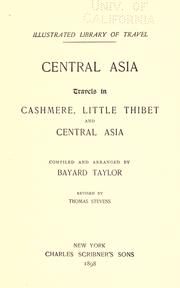TRAVELS IN CENTRAL ASIA
CHAPTER 1
THE COUNTRIES OF CENTRAL ASIA
THE name "Central Asia" correctly describes, in a geographical sennse, the heart of that continent. It is separated from the river-system of the Aral and Caspian Seas, on the west, by almost impassable mountain-ranges; from the affluents of the Indus and Ganges, on the south, by the chain of the Kuen-lun, the rival of the Himalayas, and from the rivers of China to the eastward, by the great Desert of Gobi.
Buy this book

A travelogue, heading east through Kashmir into Tibet and Central Asia.
Publish Date
1874
Publisher
Scribner, Armstrong, and Co.
Buy this book

Previews available in: English
Places
Central Asia, Tibet (China), Kashmir, TibetTimes
early 1850sShowing 10 featured editions. View all 14 editions?
| Edition | Availability |
|---|---|
| 01 |
bbbb
Libraries near you:
WorldCat
|
| 02 |
bbbb
|
| 03 |
bbbb
|
| 04 |
bbbb
|
| 05 |
bbbb
Libraries near you:
WorldCat
|
| 06 |
bbbb
|
|
07
Central Asia: Travels in Cashmere, Little Thibet and Central Asia.
1874, Scribner, Armstrong, and Co.
Electronic resource
|
aaaa
|
|
08
Central Asia: Travels in Cashmere, Little Thibet and Central Asia
1874, Scribner, Armstrong, and company
|
bbbb
Libraries near you:
WorldCat
|
| 09 |
bbbb
|
| 10 |
bbbb
|
Book Details
Published in
New York
Edition Notes
The Physical Object
ID Numbers
Excerpts
added by Katharine Hadow.
Mr. Vigne...gives the following description of the native villages: "They are clusters of flat-roofed huts, the poorer kinds looking very dirty, with smoke marks on the walls, and cakes of cow-dung sticking to them, for the purpose of being dried and used as fuel. The better kind of hut is distinguished by its new and clean mud walls: the ends of the rafters project neatly from the sides of the building, and the roof itself is free from holes, except the one used as a chimney."
Page 38,
added by Katharine Hadow.
Mr. Vigne's visit was shortly after the Sikh conquest of Cashmere, which accounts for the ruined state of the country at the time.
Page 45,
added by Katharine Hadow.
"Cashmere is known to us chiefly through its famous shawls, of which it produces annually about 30,000. Those of the finest quality bring, in London, from L100 to L400 each. Near 16,000 looms are continually employed in their manufacture.
There are now," wrote Mr. Vigne... "but five or six hundred shawl-frames in the city. (This great reduction was the result of the Sikh conquest. Prosperity has since been restored.) Formerly they were infinitely more numerous. It occupies six or seven frames, of two men at each, for six months, to make a pair of very large and handsome shawls. ....When [the poshm] arrives in Cashmere the governor ... sells it again to the merchants, at twenty per cent. profit..., he keeping the difference for himself. The white poshm may then be purchased in the city at about four small rupees ($1.40) for two pounds."
There are now," wrote Mr. Vigne... "but five or six hundred shawl-frames in the city. (This great reduction was the result of the Sikh conquest. Prosperity has since been restored.) Formerly they were infinitely more numerous. It occupies six or seven frames, of two men at each, for six months, to make a pair of very large and handsome shawls. ....When [the poshm] arrives in Cashmere the governor ... sells it again to the merchants, at twenty per cent. profit..., he keeping the difference for himself. The white poshm may then be purchased in the city at about four small rupees ($1.40) for two pounds."
Page 56,
added by Katharine Hadow.
"As soon as a shawl is made, notice is given to the inspector, and none can be cut from the loom but in his presence. It is then taken to the custom-house and stamped, a price is put upon it by the proper officer, and twenty-five per cent. on the price is demanded. When it is purchased, and about to leave the valley with its owner, the latter has to pay another four rupees for permit duty, and another seal which enables him to pass with his property; but he is afterward subjected to further duties.": p 58
Page 58,
added by Katharine Hadow.
"The broker who transacts business between the shawl manufacturer and the merchant, is a person of great importance in the city, and the manner in which their transactions are carried on is rather singular. They have correspondents in most of the larger cities of Hindustan, whose business it is to collect and forward every species of information connected with their trade. By their means they seldom fail to hear of any merchant who is about to start for Cashmere, even from such a distance as Calcutta, and, if he be a rich man, the broker will send as far as Delhi to meet him and invite him to become his guest during his sojourn in the valley"
Page 59,
added by Katharine Hadow.
Community Reviews (0)
Feedback?| October 4, 2021 | Edited by Jenner | Merge works |
| August 12, 2020 | Edited by MARC Bot | remove fake subjects |
| May 16, 2020 | Edited by ImportBot | import existing book |
| November 28, 2012 | Edited by AnandBot | Fixed spam edits. |
| December 9, 2009 | Created by WorkBot | add works page |


















